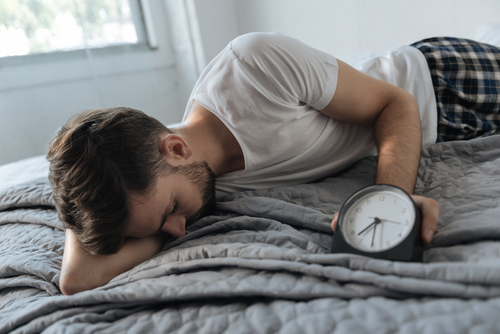Bright Light Therapy Helps Parkinson’s Sleep Disturbances, Study Suggests
Written by |

Bright light therapy can help improve sleep in people with Parkinson’s disease, likely due to its effects on the body’s “clock” genes that become dysregulated due to Parkinson’s treatment, a new study suggests.
The study, “Bright light improves sleep in patients with Parkinson’s disease: possible role of circadian restoration,” was published in Scientific Reports.
Sleep problems are one of the most common non-motor symptoms of Parkinson’s disease. There aren’t any universally agreed-upon guidelines for how to treat sleep disturbances in Parkinson’s patients. Such treatment is particularly complicated because some sleep medications may interfere with treatments for Parkinson’s itself. As such, there is a need for non-pharmacological interventions for sleep in Parkinson’s.
One such intervention is bright light therapy, which, as its name suggests, involves exposure to a bright light. Previous studies have shown this therapy to be effective at treating sleep problems in Parkinson’s disease. However, these studies usually have had small sample sizes, so there is a need to confirm their findings.
Although it is unclear exactly how bright light therapy affects the body’s biology to regulate sleep, it is thought that it can improve the circadian rhythm — our body’s “natural clock” that regulates essential functions such as sleep or metabolism, and is known to be poorly regulated in people with Parkinson’s.
In the new study, researchers assessed 16 Japanese people with Parkinson’s disease (four male, 12 female, age range 52–80 years). All of them were receiving dopaminergic therapy (DT) with levodopa or related medications.
The study participants were given bright light therapy for one hour in the evening every day for about three months. During the first and last week, the participants were hospitalized, and their exposure to light and mealtimes were closely controlled, since these external factors are known to affect sleep patterns and bodily rhythms in general.
Participants’ sleep was assessed with two questionnaires: the Epworth Sleepiness Scale (ESS), a general measurement of sleepiness, and the Parkinson Disease Sleep Scale 2 (PDSS-2), which is specific to Parkinson’s.
There were no significant differences in ESS scores before and after bright light therapy. However, scores on the PDSS-2 significantly decreased, from 20.56 to 14.56 points, indicating improved sleep quality. Further analysis of these scores suggested that the improvement was driven primarily by decreased nocturia (waking up to urinate) and limb pain.
The researchers then divided the participants into a younger group and an older group, with eight participants in each, to see whether age affected these scores.
“Interestingly, although the sample size is likely too small to make solid conclusions, the results suggest that BLT [bright light therapy] induced a statistically significant improvement in PDSS score only in the younger group,” the researchers wrote.
The researchers then examined the biological effects of bright light therapy that could account for these improvements. Circadian genes, sometimes called “clock” genes, are active (or not) at specific times throughout the day; this helps to regulate behaviors and feelings that are tied to time, such as hunger and sleepiness. The researchers hypothesized that bright light therapy might affect these genes.
To test this, the team analyzed the expression of three clock genes (Per3, Nr1d1 and Nr1d2) in hair follicle cells collected from the participants at regular intervals during the hospitalizations. They found that, following bright light therapy, the expression of these genes was altered in participants with Parkinson’s disease. Furthermore, in 75% of participants who experienced sleep improvement (based on PDSS-2 scores), there were consistent changes in clock gene expression.
“Although the causal link remains unclear, we speculate that functional modulation of the circadian clock is a potential mechanism underlying the [bright light therapy]-mediated sleep improvement in [Parkinson’s] patients receiving [dopaminergic therapy],” the researchers wrote.
The circadian rhythm is largely controlled by part of the brain called the suprachiasmatic nucleus (SCN). Because this brain region is sensitive to dopamine, the researchers hypothesized that increased dopamine exposure, due to dopaminergic therapy, could lead to the identified circadian dysfunction.
To test this, the researchers treated mouse SCNs in dishes with excess dopamine. As expected, the expression of clock genes was altered following prolonged dopamine exposure. Of note, gene expression is the process by which information in a gene is synthesized to create a working product, like a protein.
“Together, these results suggest that functional defects in the SCN caused by chronic exposure to dopamine may in part underlie the sleep problems observed in [Parkinson’s] patients receiving [dopaminergic therapy],” the researchers wrote.
“In conclusion,” they added, “we demonstrated that [bright light therapy] is a promising medical treatment for improving sleep in [Parkinson’s] patients receiving [dopaminergic therapy] and that this [bright light therapy]-induced sleep improvement may arise due to restoration of circadian function.”
Recently, a light therapy-based device developed by PhotoPharmics has been granted breakthrough device designation by the U.S. Food and Drug Administration (FDA) as an add-on treatment for Parkinson’s non-motor symptoms.





